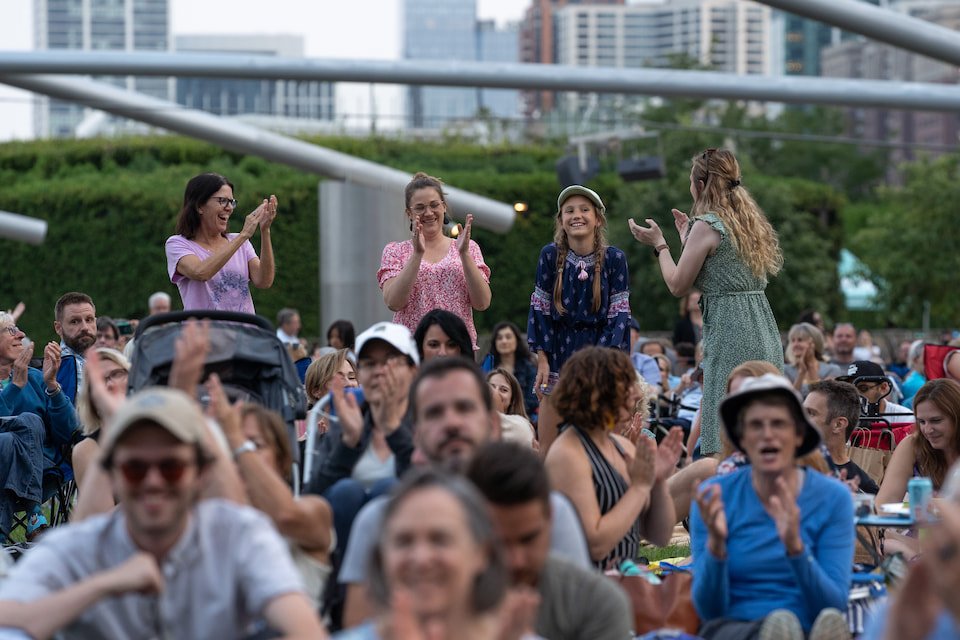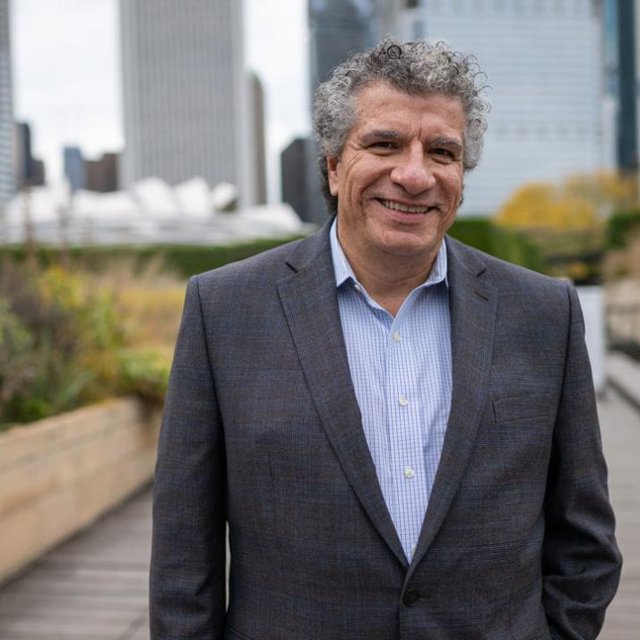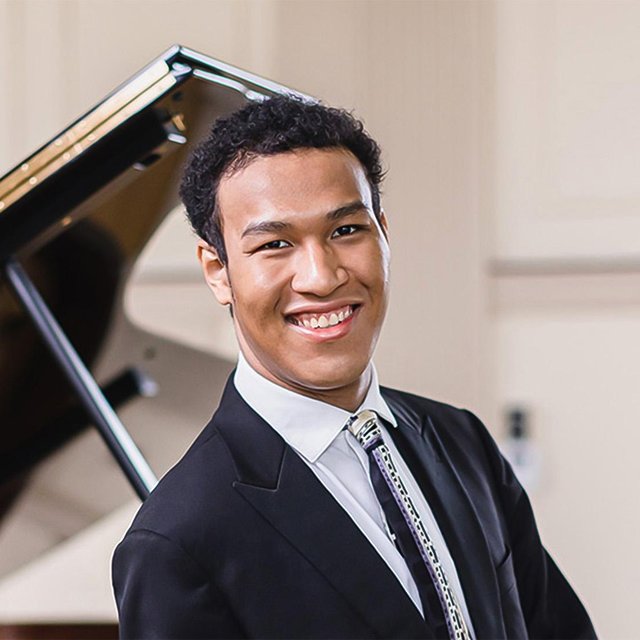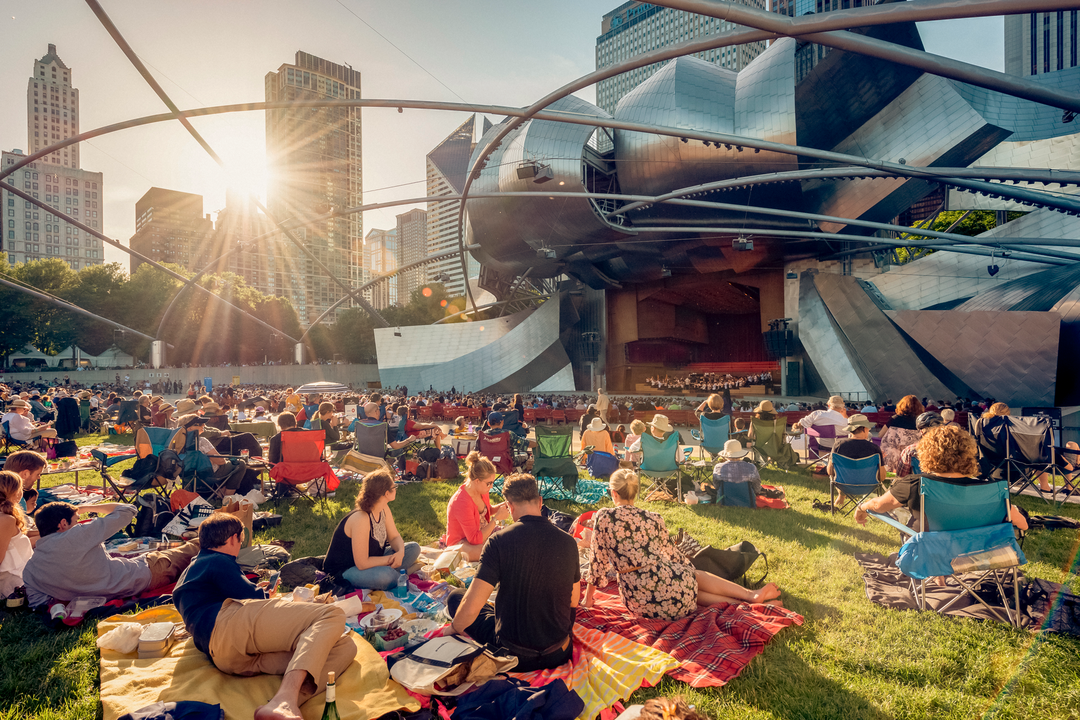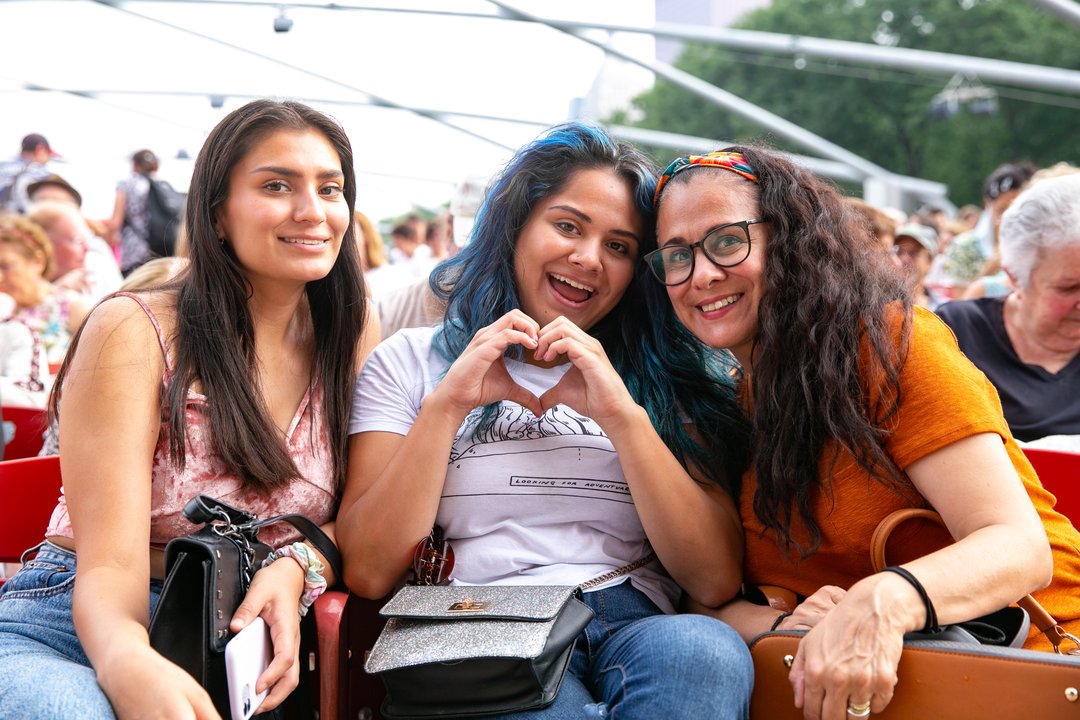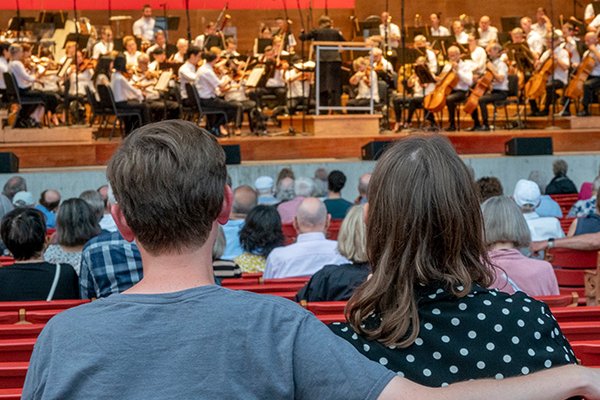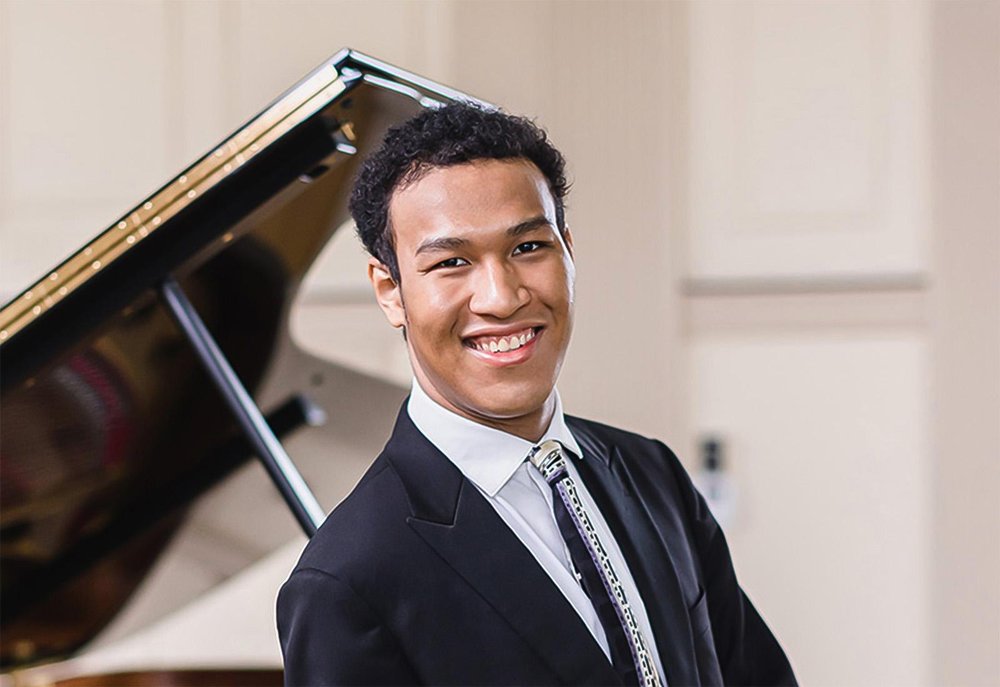
Saint-Saëns Organ Symphony
Program
Chelsea Komschlies Mycelialore (10 mins)
Franz Liszt Piano Concerto No. 1 (19 mins)
Allegro maestoso
Quasi adagio – Allegretto vivace
Allegro marziale animato
Camille Saint-Saëns Symphony No. 3, Organ (36 mins)
PART I
Adagio – Allegro moderato
Poco adagio
PART II
Allegro moderato – Presto
Maestoso – Allegro
Patrick Godon, organ
Featuring
Program Notes
Chelsea Komschlies (b. 1991)
Mycelialore (2024)
Scored for: two flutes including piccolo and alto flute, two oboes including English Horn, two clarinets including bass clarinet, two bassoons, four French horns, two trumpets, three trombones, tuba, timpani, percussion, harp, synthesizer, and strings
Performance time: 10 minutes
First Grant Park Orchestra performance
Combining her interests in neuroscience and fungi, Chelsea Komschlies’s Mycelialore envisions a fantasy world of mushrooms based on their underground root-like structure called the mycelium. “The mycelium can form networks between trees and other plants,” Komschlies explains, “and there are many ways in which these networks can function like a human brain, like neurons firing. As a composer and fantasy enthusiast, I took that idea based in real science into a fantasy realm and asked the question: if these mycelium networks kind of function like a brain, then what if they had their own folklore and their own memory? If mushrooms can remember and tell their own stories, what would they say and how would they sound?”
Mycelialore was the result of a commission from the League of American Orchestra’s Virginia B. Toulmin Foundation Orchestral Commissions Program. The Tucson Symphony Orchestra premiered the piece this past February, and the consortium ensures the new work will receive multiple performances across the country. Komschlies was one of six female and nonbinary composers selected for the program in 2023. She is currently a PhD candidate in composition at McGill University in Montreal, Canada. Each of Komschlies’s compositions, Mycelialore included, creates what she calls “a distinct fantasy world and evokes vivid multisensory imagery and a range of psycho-emotional landscapes, from whimsical nostalgia and camp to eerie disquiet, and from altered states of consciousness to glittering spiritual awe.”
Franz Liszt (1811–1886)
Concerto No. 1 in E-flat major for Piano & Orchestra, S. 124 (1835)
Scored for: three flutes including piccolo, two oboes, two clarinets, two bassoons, two French horns, two trumpets, three trombones, timpani, percussion, strings, and solo piano
Performance time: 19 minutes
First Grant Park Orchestra performance: August 16, 1935; Frank Laird Waller, conductor and Grace Nelson, piano
When you think of composers who spent a long time working on a piece, the first name that probably comes to mind is Johannes Brahms, who toiled over his First Symphony for 21 years. Well, Franz Liszt has him beat—it took Liszt 25 years to complete his Piano Concerto No. 1 in E-flat major. The earliest sketches date from 1830. He then drafted his first and second piano concertos concurrently in 1839, making further revisions to the first in 1849 and 1853. Although Liszt was his generation’s preeminent piano virtuoso, he was less assured as a composer, often spending many years revising his compositions. He also did not have much time to devote to composing until 1847, when he decided to give up his international performing career in favor of a more stable job as Kapellmeister in Weimar. With more time on his hands and an orchestra at his disposal, Liszt was able to hone his compositional skills and finally complete his Piano Concerto No. 1 in 1855, premiering the work himself with Hector Berlioz on the podium.
“Das versteht ihr alle nicht, haha!” (“You do not understand any of this, haha!”) Supposedly, Liszt and his son-in-law, pianist and conductor Hans Bülow, privately sang these words to the concerto’s opening melody in defiance of the work’s critics. Given the enduring popularity of Liszt’s Piano Concerto No. 1, it is easy to forget how innovative it was at the time, thwarting audience expectations for several reasons. First is the matter of form. Liszt sets the concerto in four movements instead of the usual three, following the structure of a symphony instead of that of a concerto. The concerto proceeds largely without pause, only breaking between the first and second movements. Liszt further unifies the concerto into one organic whole by recalling and transforming themes across movements. Liszt explained that the finale “is only an urgent recapitulation of the earlier material with quickened, livelier rhythm, and it contains no new motifs . . . This kind of binding together and rounding off a piece at its close is somewhat my own, but it is quite organic and justified from the standpoint of musical form.”
Most innovative is Liszt’s treatment of the soloist versus the orchestra. The orchestra and soloist do not alternate in the way that was expected for a concerto of the time. There are no long orchestral passages to set up the soloist. Instead, the piano is more integrated into the orchestra and is often put in dialogue with other solo instruments such as the flute, clarinet, viola, and even triangle. Most contemporary critics expected Liszt’s concerto to be just another vehicle for him to show off his unsurpassed piano technique. While the piece does require dazzling pianistic feats, Liszt actually simplified the piano part over time. Revealing his compositional maturity, he ensured that the virtuosity was never gratuitous but always served an artistic purpose.
Camille Saint-Saëns (1835–1921)
Symphony No. 3 in C minor, Organ Symphony, op. 78 (1886)
Scored for: three flutes including piccolo, three oboes including English Horn, three clarinets including bass clarinet, three bassoons including contrabassoon, four French horns, three trumpets, three trombones, tuba, timpani, percussion, organ, piano, and strings
Performance time: 36 minutes
First Grant Park Orchestra performance: July 2, 1969; Irwin Hoffman, conductor
Camille Saint-Saëns owed a great deal to Franz Liszt. Liszt had been Saint-Saëns’s champion early in his career, leveraging his influence to arrange the premiere of Samson et Dalila in Weimar when no one in Paris would touch the opera. The Hungarian piano virtuoso was also impressed by Saint-Saëns’s skill at the keyboard, calling him “the greatest organist in the world” after hearing him improvise at La Madeleine in Paris. The admiration was mutual. Saint-Saëns, in turn, became an ambassador for Liszt’s works in France. As a composer, he was highly influenced by Liszt’s evocative tone poems and his method of cyclic thematic transformation, where musical material is developed across movements of a piece, as we just heard in Liszt’s Piano Concerto No. 1. Saint-Saëns extends this technique in his Symphony No. 3, which he dedicated in memory of Liszt, who died just weeks after the work’s premiere in London on May 19, 1886.
Although Saint-Saëns’s Symphony No. 3 is often called the “Organ Symphony,” the nickname was not the composer’s own. The name implies that the organ is the star of the show, when in reality, the organ is more absent from the score than not. It is treated as another instrumental color (albeit a powerful one) within the scope of the orchestra, much like the piano scored for two and four hands in the second movement. The more notable innovations of this symphony lie in its form and motivic development. Here, the usual four-movement symphonic structure is condensed into two, although the sections within the two movements align with the usual symphonic plan of allegro, adagio, scherzo, and finale. However, Saint-Saëns removes sections where musical material would typically be recapitulated and binds movements together.
Across these condensed and conjoined movements, Saint-Saëns repeatedly transforms the same melodic material. After a slow introduction comes the first statement of the symphony’s motto in the form of nervous sixteenth notes in the strings, reminiscent of the opening of Schubert’s “Unfinished” Symphony No. 8. This motive recurs in the slow section as creeping double bass pizzicatos, having lost some of its restlessness after the serenity of the quiet bed of organ sound and lyrical string melody that precede it. In the darkly hued scherzo, the motive undergoes further diminution, becoming more anxious than ever. The organ heralds the finale in a way only the king of instruments can—with a massive, soul-stirring C-major chord. This time, the theme reaches its apotheosis as a broad chorale, first with nostalgic strings accompanied by tinkling piano arpeggios before a statement on full organ. The theme then forms the basis of a celebratory fugue. Listening to the exuberant finale, you can’t help agreeing with Saint-Saëns, who said this symphony marked his greatest accomplishment: “I have given it all that I had to give . . . What I have done I shall never do again.”
—Katherine Buzard
Artistic Leadership
Support The Festival
Violin I
Jeremy Black, concertmaster
Vacant, assistant concertmaster
Trista Wong
Zulfiya Bashirova
Jennifer Cappelli
Injoo Choi
Dima Dimitrova
Erica Hudson
Hyewon Kim
Matthew Lehmann
Jayna Park
Rika Seko
Karen Sinclair
Bonnie Terry
Krzysztof Zimowski
Violin II
Liba Shacht, principal
Vacant, assistant principal
Ying Chai
Ran Cheng
Karl Davies
Likai He
Ann Lehmann
Laura Miller
Cristina Muresan
Kjersti Nostbakken
Irene Radetzky
Jeanine Wynton
Thomas Yang
Viola
Terri Van Valkinburgh, principal
Yoshihiko Nakano, assistant principal
Elizabeth Breslin
Beatrice Chen
Amy Hess
Rebecca Swan
Chloé Thominet
Cello
Walter Haman, principal
Peter Szczepanek, assistant principal
Calum Cook
Larry Glazier
Steven Houser
Eric Kutz
Eran Meir
Double Bass
Colin Corner, principal
Peter Hatch, assistant principal
Andrew Anderson
Christian Luevano
Samuel Rocklin
Chunyang Wang
Chris White
Flute
Vacant, principal
Alyce Johnson
Jennifer Lawson, assistant principal
Piccolo
Jennifer Lawson
Oboe
Mitchell Kuhn, principal
Vacant
Anne Bach, assistant principal
English Horn
Anne Bach
Clarinet
Dario Brignoli, principal
Trevor O’Riordan, assistant principal
Besnik Abrashi
Bass Clarinet
Besnik Abrashi
Bassoon
Eric Hall, principal
Nicole Haywood Vera Tenorio, assistant principal
Vacant
Contrabassoon
Vacant
Horn
Vacant, principal
Stephanie Blaha, assistant principal
Neil Kimel
Brett Hodge
Paul Clifton
Trumpet
David Gordon, principal
Mike Brozick
Vacant, assistant principal
Vacant
Trombone
Daniel Cloutier, principal
Jeremy Moeller, assistant principal
Bass Trombone
Alexander Mullins
Tuba
Andrew Smith, principal
Timpani
Daniel Karas, principal
Josh Jones, assistant principal
Percussion
Josh Jones, principal
Vacant, assistant principal
Doug Waddell
Harp
Kayo Ishimaru-Fleisher, principal
Keyboards
Christopher Guzman
Orchestra Librarian
Eliza Bangert, principal
Grant Park Chorus
* denotes leave-of-absence † 2025 Vocal Fellow
Laura Lynch Anderson
Kristina Bachrach
Madalynn Baez
Megan E. Bell
Alyssa Bennett
Tamara Bodnar
Kylie Buckham
Anna Joy Buegel
Laura Bumgardner
Katherine Buzard
Bethany Clearfield
Nathalie Colas
Carolyne DalMonte
Megan Fletcher
Kaitlin Foley
Saira Frank
Julia Frodyma
Katherine Gray-Noon
Kimberly Gunderson
Alexandra Ioan
Alexandra Kassouf
Darlene Kelsey
Olivia Knutsen
Marybeth Kurnat
Katelyn Lee
Kyuyim Lee+
Rosalind Lee
Veronica Mak
Hannah Dixon McConnell
Marie McManama
Kathleen Monson
Susan Nelson
Evangeline Ng
Máire O'Brien
Alexandra Olsavsky
Laura Perkett
Angela Presutti Korbitz
Alexia Rivera
Veronica Samiec
Emily Sinclair
Molly Snodgrass
Tiana Sorenson
Christine Steyer
Sarah van der Ploeg*
Lydia Walsh-Rock
Sherry Watkins
Emily Amesquita
Melissa Arning
Christina Bernardoni
Angela Born
Bethany Brewer
Julie DeBoer
Leah Dexter
Katrina Dubbs
Stacy Eckert
Margaret Fox
Catarine Hancock
Ruth Ginelle Heald
Sophia Heinz
Miya Higashiyama
Carla Janzen
Amy Allyssa Johnson
Kathryn Kinjo Duncan
Amanda Koopman
Anna Laurenzo
Jeannette Lee
Thereza Lituma
Chelsea Lyons
Victoria Marshall
Jessica McCarthy
Quinn Middleman
Ella Peters
Sarah Ponder
Emily Price
Stephanie Schoenhofer
Suzanne A. Shields
Marissa Simmons
Cassidy Smith
Aidan Spencer
Alannah Spencer
Margaret Stoltz
Carolyn Sundlof Boudreau
Gabrielle Timofeeva López
Elizabeth Vaughan
Corinne Wallace-Crane
A.J. Wester
Debra Wilder
Isabel Yang+
Charles Anderson
Enrico Giuseppe Bellomo
Justin Berkowitz
Madison Bolt
Hoss Brock
Steven Caldicott Wilson
Opal Clyburn-Miller+
John J. Concepción
Micah Dingler
Jared V. Esguerra
Alec Fore
Ace Gangoso
Klaus Georg
Tejas Gururaja
Paul Hunter
Garrett Johannsen
William Johnson
James Judd
Tim Lambert
Tyler Lee
Stephen D. Noon
Marcos Ochoa
Brett Potts
Nicholas Pulikowski
Peder Reiff
Samuel Rosner
Matthew W. Schlesinger
Joe Shadday
Aaron Short
Brian Skoog
Michael St. Peter
Ryan Townsend Strand
Alan Taylor*
Sean J. Watland
Nate Widelitz
Walter Aldrich
Evan Bravos
Matthew Brennan
Michael Cavalieri
Ryan J. Cox
Ed Frazier Davis
Lifan Deng
Matthew Dexter+
Chris DiMarco
Christopher Filipowicz
Dimitri German
Dominic German
David Govertsen
Spencer Greene
Brian Hupp
Jan Jarvis
Jess Koehn
Eric Miranda
Ian Morris
Ian Murrell
John E. Orduña
Wilbur Pauley
Douglas Peters
Jackson Pierzina
Martin Lowen Poock
Ian Prichard
Dan Richardson
Stephen Richardson
Benjamin D. Rivera
Scott Uddenberg
Schyler Vargas
Vince Wallace
Aaron Wardell
Ronald Watkins
Jonathon Weller
Peter Wesoloski
Jonathan Wilson
Chuck Foster
John Goodwin
Kyuyim Lee
Isabel Yang
Opal Clyburn-Miller
Matthew Dexter
